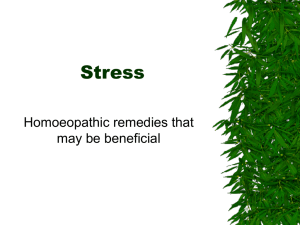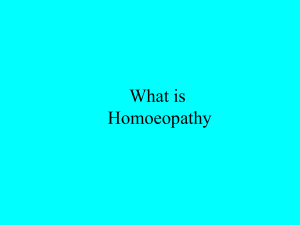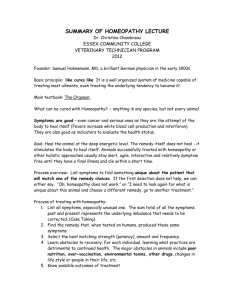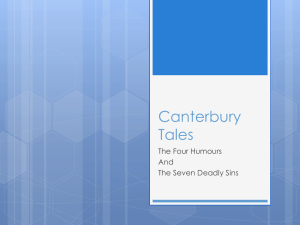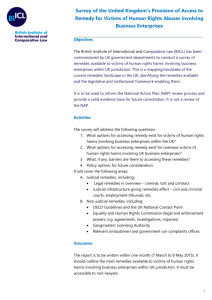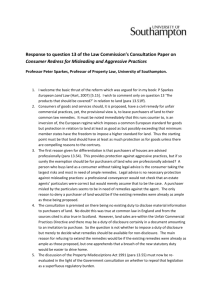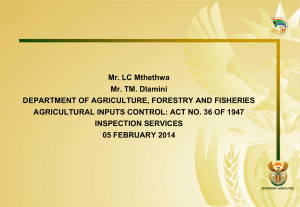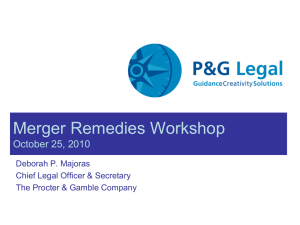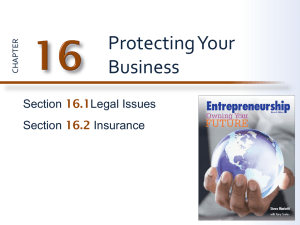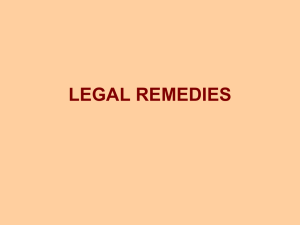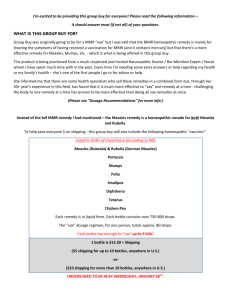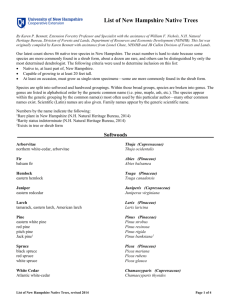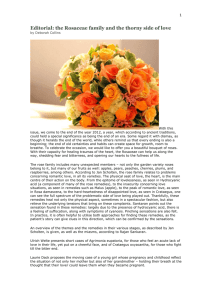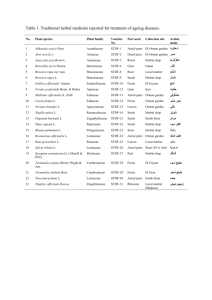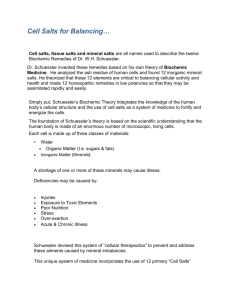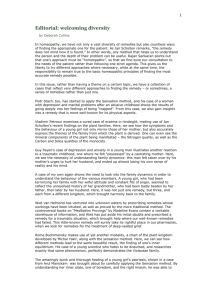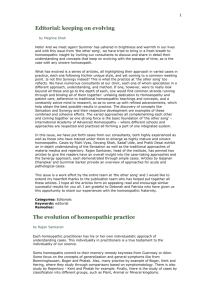Precautions, complications, contra
advertisement
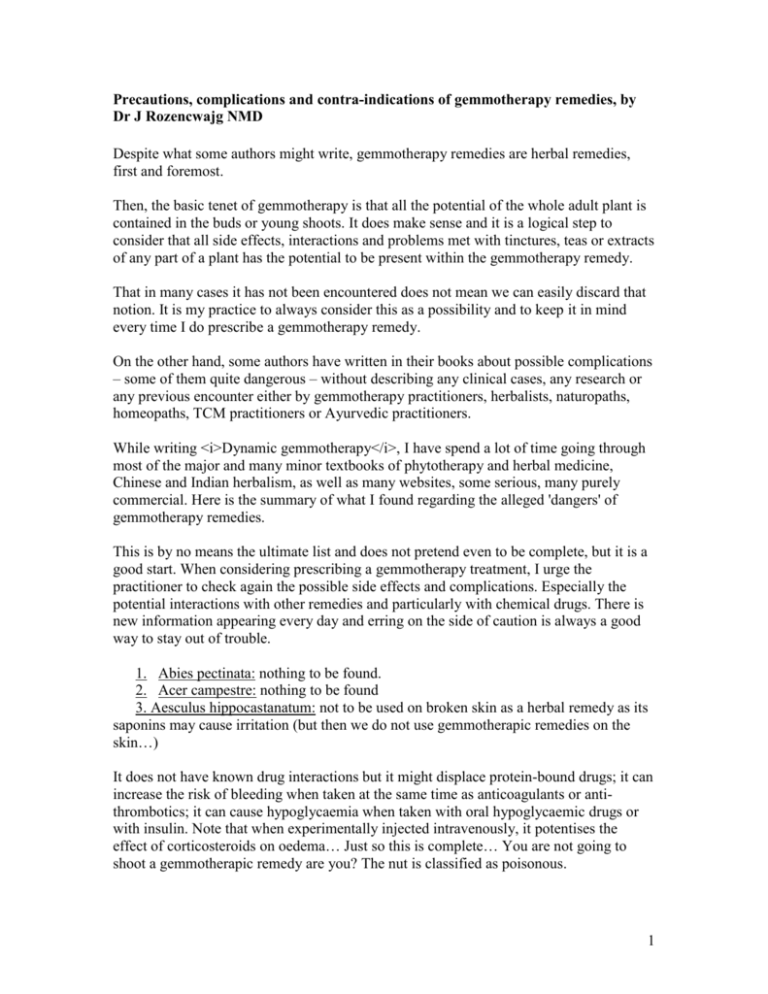
Precautions, complications and contra-indications of gemmotherapy remedies, by
Dr J Rozencwajg NMD
Despite what some authors might write, gemmotherapy remedies are herbal remedies,
first and foremost.
Then, the basic tenet of gemmotherapy is that all the potential of the whole adult plant is
contained in the buds or young shoots. It does make sense and it is a logical step to
consider that all side effects, interactions and problems met with tinctures, teas or extracts
of any part of a plant has the potential to be present within the gemmotherapy remedy.
That in many cases it has not been encountered does not mean we can easily discard that
notion. It is my practice to always consider this as a possibility and to keep it in mind
every time I do prescribe a gemmotherapy remedy.
On the other hand, some authors have written in their books about possible complications
– some of them quite dangerous – without describing any clinical cases, any research or
any previous encounter either by gemmotherapy practitioners, herbalists, naturopaths,
homeopaths, TCM practitioners or Ayurvedic practitioners.
While writing <i>Dynamic gemmotherapy</i>, I have spend a lot of time going through
most of the major and many minor textbooks of phytotherapy and herbal medicine,
Chinese and Indian herbalism, as well as many websites, some serious, many purely
commercial. Here is the summary of what I found regarding the alleged 'dangers' of
gemmotherapy remedies.
This is by no means the ultimate list and does not pretend even to be complete, but it is a
good start. When considering prescribing a gemmotherapy treatment, I urge the
practitioner to check again the possible side effects and complications. Especially the
potential interactions with other remedies and particularly with chemical drugs. There is
new information appearing every day and erring on the side of caution is always a good
way to stay out of trouble.
1. Abies pectinata: nothing to be found.
2. Acer campestre: nothing to be found
3. Aesculus hippocastanatum: not to be used on broken skin as a herbal remedy as its
saponins may cause irritation (but then we do not use gemmotherapic remedies on the
skin…)
It does not have known drug interactions but it might displace protein-bound drugs; it can
increase the risk of bleeding when taken at the same time as anticoagulants or antithrombotics; it can cause hypoglycaemia when taken with oral hypoglycaemic drugs or
with insulin. Note that when experimentally injected intravenously, it potentises the
effect of corticosteroids on oedema… Just so this is complete… You are not going to
shoot a gemmotherapic remedy are you? The nut is classified as poisonous.
1
4. Alnus glutinosa: nothing to be found.
5. Alnus incana: nothing to be found.
6. Ampelopsis weitchii: nothing to be found.
7. Betula pubescens (Betula alba): may increase the serum levels of lithium.
8. Betula verrucosa (Betula pendula): may increase the serum levels of lithium.
9. Carpinus betulus: nothing to be found.
10. Castanea vesca: nothing to be found.
11. Cedrus libani: preferably to be avoided during pregnancy, it can cause abortions
according to herbal medicine literature.
12. Cercis siliquastrum: nothing to be found.
13. Citrus limonum: nothing to be found.
14. Cornus sanguinea: nothing to be found.
15. Corylus avellana: nothing to be found.
17. Crataegus oxycantha: Some herbalists recommend not using Crataegus in patients
suffering from low blood pressure; it has an ACE inhibitor effect and might theoretically
potentise pharmacological ACE inhibitors or other hypotensive drugs. Nevertheless,
other herbalists, and my own experience, are disagreeing and find Crataegus to be an
amphoteric remedy, regulating the blood pressure towards normal ('amphoteric' =
something with the characteristics of two apparently opposite and contradictory states;
therefore having a regulating and normalising effect). It would be wise to have the patient
monitor their blood pressure regularly and adapt the treatment as needed, preferably by
changing the conventional drugs, which are loaded with side effects.
There is a very good review of positive interaction between Crataegus and Digoxin in the
book <i>Herbs, Nutrients and Drugs Interaction</i> by Mitchell Stargrove. In Sharon
Herr’s <i>Herb-Drug Interaction Handbook</i>, I found the following interactions and
precautions: it could potentise antihypertensive drugs and the hypotensive action of
general anaesthetics; increase the risk of arrhythmia when using depolarizing muscle
relaxants (therefore inform the anaesthetist about taking Crataegus AND tell him/her
what it can do as most do not know); it antagonizes sympathomimetics (= drugs that
mimic the effects of adrenaline and produces effects similar to those of the sympathetic
nervous system); and can increase CNS depression and hypotension when used
concurrently with anticonvulsivants, antihistamines, antipsychotics, benzodiazepine and
tricyclic antidepressants. Therefore use low doses of the gemmotherapy remedy to start
and increase progressively up to therapeutic levels while carefully monitoring your
patient.
If you are using other herbs concommitantly remember the synergies with Convallaria
majalis, Digitalis, Strophanthus, Urginea, Apocynum cannabinum and other cardiac
glycosides, hypotensive synergy with Veratrum and Rauwolfia as well as the vasodilating
synergy with vasodilating herbs.
18. Fagus Sylvatica: nothing to be found.
19. Ficus Carica: nothing to be found.
20. Fraxinus Excelsior: nothing to be found.
21. Ilex Aquifolium: nothing to be found.
2
22. Juglans Regia: nothing to be found.
23. Juniperus Communis: there is a warning to avoid Juniperus during pregnancy or
when there is an active kidney disease or infection; this last relative
contraindication is disputed. According to Sharon Herr, who gives plenty of
references, it may potentiate antihypertensive drugs, potassium-sparing diuretics
and loop diuretics, thiazide diuretics, spironolactone, insulin and oral
hypoglycaemic drugs, lithium; may increase the toxicity of cardiac glycosides and
increase the risk of hypokalemia when used with antiarrhythmics, corticosteroids
and diuretics. When looking the references up, most of them is 'potential', within a
list of possibilities……..so be aware of the possibilities, monitor BP, K,
glycaemia and clinical reaction, but do not withhold a helpful treatment.
24. Ligustrum Vulgare: nothing to be found.
25. Lonicera Nigra: nothing to be found.
26. Malus Sylvestris: nothing to be found.
27. Olea Europea: The tinctures or decoctions of the leaves can cause gastric
irritation and should not be taken on an empty stomach. When using the gemmotherapy
concentrate, mention that possibility to the patient and suggest testing the reaction with
one drop at the start of the treatment.
The leaf has been reported as having the potential to cause hypoglycaemia when used
concomitantly with insulin or oral hypoglycaemic drugs. This should be mentioned to the
patient.
28. Pinus Montana: nothing to be found.
29. Platanus Orientalis: nothing to be found.
30. Populus Nigra: Not to be given to patients allergic to aspirin. There is a
theoretical risk of bleeding when used with aspirin and anticoagulants. It could also
reduce the effect of uricosuric drugs (probably by competition for receptors, theoretical).
Because of the claim that it can cause hepatocellular degeneration, it is recommended
to restrict its use to 4 weeks only.
31. Prunus Amygdalus: nothing to be found.
32. Quercus Robur: Very astringent as a decoction, the usual recommendation is not
to take it for more than 4 weeks (or even less) as it can prevent the absorption of
nutrients. I doubt this would be the case with the gemmotherapy remedy due to
the small amount used and the need for a large surface to be in direct contact
with the decoction for it to tan the whole digestive mucosa. I did a personal trial
of 4 months, 10 drops/day, with no digestive problems whatsoever. It is also
reported that the tannins in the herb could interfere with the absorption of
conventional drugs, but again the small amounts used in gemmotherapy do not
appear to have any relevance for that interaction; still, recommend not taking
them together and avoid hassles.
33. Ribes Nigrum: an excessive dose can create a state of 'adrenal overdrive' with
symptoms and signs compatible with excessive secretion of adrenaline,
tachycardia, chest constriction, sometimes chest pains. I am also recommending
taking the remedy in the morning to imitate the natural cortisol cycle and not to
prevent sleep.
34. Rosa Canina: nothing to be found.
3
35. Rosemarinus Officinalis: One publication claims it has a hyperglycaemic
effect and inhibits the release of insulin (Al-Hader, J. Ethnopharmacology 1994) and
therefore is now listed as capable of counteracting the effect of insulin or oral
hypoglycaemic drugs, so reported in the Commission E monograph……..allow me to
doubt that; with its extensive culinary and traditional, folk use, this is something that
would have emerged a long time ago.
The aromatherapic warning about epilepsy when used in high doses should be heeded
and when using the concentrated remedies for medicinal purposes, it is good to remember
to start with low doses and build tolerance or reach the limit progressively while always
watching for potential side-effects. This does not apply to gastronomic uses, of course.
36. Rubus Fructicosus: nothing to be found.
37. Rubus Idaeus: The tannin content could prevent the absorption of conventional
drugs, but here again, I doubt the small amount used would have any effect at
all; there is also the theoretical possibility of increasing the hypoglycaemic
effect of insulin and oral hypoglycaemic drugs.
38. Secale Cereale: nothing to be found.
39. Sequoia Giganea: nothing to be found.
40. Sorbus Domestica: nothing to be found.
41. Syringa Vulgaris: nothing to be found.
42. Tamaris Gallica: nothing to be found.
43. Tilia Tomentosa: nothing to be found.
44. Ulmus Campestris: nothing to be found.
45. Vaccinum Vitis Idaea: nothing to be found.
46. Viburnum Lantana: nothing to be found.
47. Viscum Album: Sharon Herr gives references for potential interferences with
anticoagulants, antidepressants, antihypertensives, heart drugs, diuretics and
immunosuppressants. They seem more theoretical than anything else and should
not deter us from an effective therapy…….just be alert.
48. Vitis Vinifera: nothing to be found, except the well known effects of overdosing
on the tincture of the fruit…….
49. Zea Mays: nothing to be found.
Even though it took me a very long time to go through all my references and sometimes
checking the references given within the references, I cannot remember and have not
even tried to memorize what I just wrote….there is just not enough space in the hard
drive between my ears. Therefore I have the habit of checking each and every remedy I
prescribe, be it Herbal or gemmotherapy, unless I have used it so many times that I am
certain of its effects and side effects; this is also the best way to eventually remember all
that information and the patients who see me doing that are often very impressed that I
take time to check my own prescription. Sometimes too, reading about other indications
and interactions leads me to ask a few more questions, at times getting some
extraordinarily important information that changes the whole plan and the whole
approach to the treatment.
4
5
